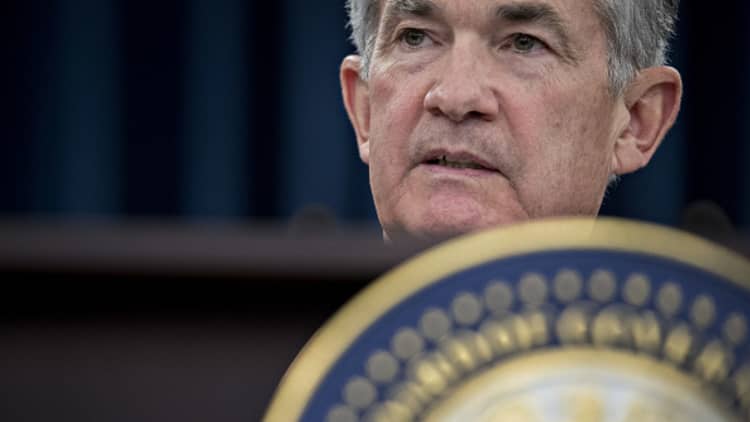
The outlook for inflation — and for Fed rate hikes to counter the threat — continues to push higher.
The CNBC Fed Survey sees little chance for a hike at May's two-day meeting, which begins Tuesday, but an 86 percent chance that the Fed will hike in June.
The 37 respondents to the survey — economists, fund managers and strategists — are split over whether the Fed will hike an additional two or three times after June. About 46 percent of respondents see two more in 2018 and the same percentage see three.
"Strong economic momentum and accelerating price and wage gains should lead to three more Fed rate hikes this year,'' Kathy Bostjancic, head of U.S. macro investor services at Oxford Economics USA, wrote in response to the survey.
For 2019, the median is for two hikes, but most of the risk looks to be with more rates rises. Forty-three percent forecast either three or four hikes next year.
In the past year, the median outlook for the Fed's top rate in this hiking cycle has risen by nearly 60 basis points to 3.24 percent. The Fed is forecast to hit its so-called terminal rate in the third quarter of next year.
"With inflation firming and the economy likely to regain speed, the Fed has no reason to fight the market," wrote Lynn Reaser, chief economist, Point Loma Nazarene University. "Look for a steady diet of a rate hike each quarter."
Inflation outlook
The outlook for inflation continues to rise, with respondents raising their consumer price index forecasts in this survey and in four of the past five surveys. Year-over-year inflation is forecast to hit 2.45 percent this year, up from a 2.14 percent low forecast last July for 2018.
After a weak first quarter, respondents shaved their outlook a bit for 2018 GDP to 2.7 percent but raised it to 2.8 percent for next year. The probability of recession in the next 12 months remains low at 16.5 percent, though up a bit from earlier this year. Higher interest rates are viewed as the second biggest threat to the economic expansion, behind protectionism.
The growth outlook hinges significantly on whether tax cuts do their job and stimulate growth. And respondents disagree.
"The long-term positive effects of tax reform and less extreme regulation is not being given the merit it deserves," wrote Richard I. Sichel, senior investment strategist at Philadelphia Trust.
But Robert Brusca, chief economist at Fact and Opinion Economics, counters: "I think tax cuts and fiscal stimulus will be the big disappointments of 2018-2019. It will leave Fed policy as too aggressive."
Diane Swonk, chief economist at Grant Thornton, notes how the Fed and fiscal policy are working, seemingly, at cross purposes. "The Fed is attempting to water down the punch and even take a few glasses away, while the administration and Congress are sneaking flasks of grain alcohol into the school dance to spike the punch," Swonk said. "Tensions between the Fed and the rest of Washington will intensify."
More than two-thirds of respondents say the benefits of tax cuts for the U.S. economy will outweigh the drag from higher interest rates, and a similar percentage say the flattening yield curve does not signal a recession. As for the reasons for higher rates, respondents give almost equal weight to all the major factors: the fed, higher inflation concerns, faster growth and bigger deficits.
"The spread between the 2-year and 10-year Treasury is now the tightest it's been since 2007," said Rob Morgan, chief investment officer at Sethi: "The flattening yield curve in 2007 was a harbinger of the Great Recession of 2008. Scary stuff."
Stock outlook lowered
For the second survey in a row, respondents lowered their outlook for stocks for both this year and next. This follows a string of eight-straight increases earlier this year peaking in January. The current outlook for the S&P 500 at 2,787 for the end of this year is now 150 points, or 5 percent, below the outlook in January. But respondents still see stocks rising 7.5 percent from current levels to 2,879 by the end of 2019. Most see the recent volatility as a healthy part of the economic cycle and say it hasn't changed their view of stocks.
"It is no coincidence that a market correction and jump in volatility is happening as the Fed gets deeper into its tightening. It happens just about every time,'' said Peter Boockvar, chief investment officer at Bleakley Advisory Group.


